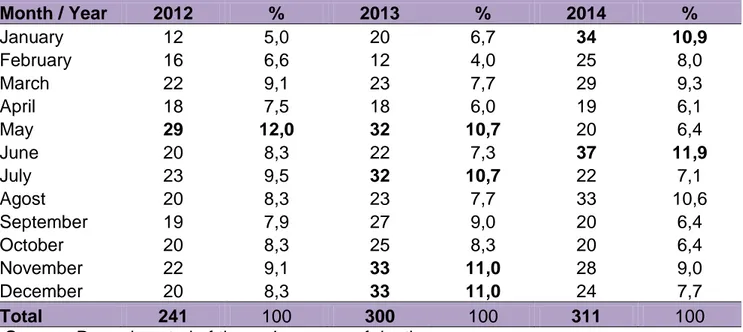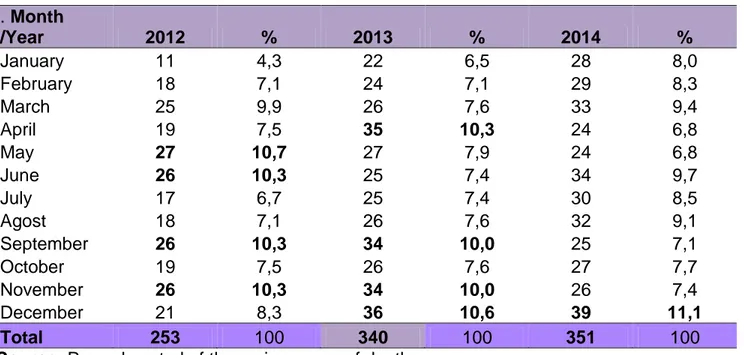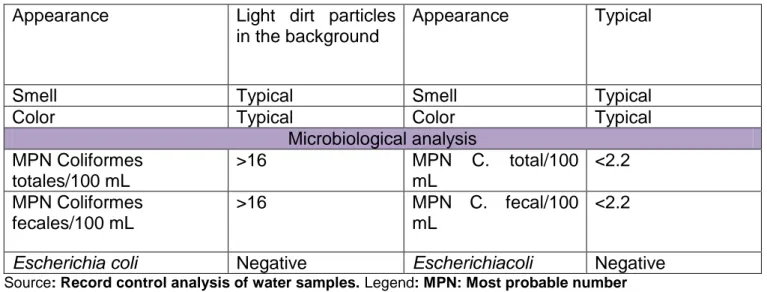Evaluación de la mortalidad en el síndrome gastroentérico, agua pienso y hallazgos anatomopatológicos en crías y precebas porcinas
Texto completo
(2) Introduction. Limitations in Cuba regarding the acquisition of food and other resources to the intensive production has resulted in the decline of pig farming specialist who struggles to recover but requires large inputs for production. This has resulted in small and medium productions, with less need for inputs, have come to occupy an important place in pig production in the country, however, this sector does not have the technical resources of specialized production (Vazquez et al., 1997) For animals growing health problems are exacerbated because pigs are regrouped and mixed, suffering high levels of stress, losing passive immunity, resulting in pneumonia two to three weeks after weaning. In conclusion, if pigs are handled in the same way, the result is the presence of a number of preventable diseases (Fuentes, 2001). This paper presents such as:. Scientific problem. Mortality in the gastro-intestinal syndromes in swine breeding and piglets categories.. Hypothesis The gastroenteric syndrome in different pig categories leads to high mortality.. General objectives: Assess mortality in the gastro-intestinal syndrome in two different swine categories and microbiological in food, drinking water and pathological results (macroscopic) animals autopsied over a period of three years.. Specific objectives: To evaluate the trend in mortality gastroenteric syndrome in swine categories: piglets breeding and in the period from 2012 to 2014 period. To analyze the results of analyzes of drinking water (teats and well), I think and pathology (macroscopic) animals autopsied in the years analyzed.. Materials and methods. The work was performed in a swine entity, evaluating mortality from gastro syndrome in two different swine categories: young and piglets in the period from 2012 to 2014. The results of the tests of drinking water were analyzed: well (032- Normative References 2: 1986) and nipples (NC: 827: 2011) as well as sensory, physical and chemical analyzes (NC: 74-22: 1985) and microbiological (NC: ISSO-605: 2008, NC: ISSO-7459: 2009, NC: ISSO-4832: 2010) start feed imported Sagarpa A-0864-112 Championships. Pathologic findings (macroscopic) of autopsied in the three years in the Provincial Veterina ry Laboratory of Villa Clara animals were evaluated. Data were obtained from passive files of the Statistics Department of swine entity, creating databases in Microsoft Excel that were exported to the statistical package SPSS version 15; The data was analyzed by descriptive statistics (analysis of time series, absolute frequency, relative frequency and average) .To determine trends moving averages are used extensively.
(3) 3 and smoothing method.. Results. and. Discussion.. In the analyzed period (2012 - 2014) died of gastrointestinal diseases piglets 944 representing 52.6% of the overall mortality of the categories analyzed, while 852 died in pig offspring to 47.4%, a difference that turned out to be significant with driveability a level of 95% (table 1). In studies on gastrointestinal processes Rodriguez et al., (1996) gets out of a total of 217 animals studied, 118 babies (54.37%) died from these diseases, while the remaining 99 (45.63%) belonging to the category piglets, also they died from gastroenteric disorders. Tabla 1. Mortalidad por el síndrome gastroentérico en crías y precebas porcinas. Mortality for gastroenteric Syndrome in newborn and piglets. Mortality Piglets Newborns Total. Absolute Frequency 944 852 1796. % 52,6 47,4 100. Source: Record control of the main causes of death. 2 X of goodness of fit =4,713 P<0,05. In 2012 the highest mortality by gastroenteric syndrome in offspring was presented in May to 12.0% in 2013 corresponded to the months of May and July (10.7%), November and December (11.0%), however in 2014 during the months of January to 10.4% and June with 11.9% (table 2). Of note (smoothing method) that from April to December 2014 the behavior of mortality was almost stationary relative to the above referred Peña et al., (2013) that have a higher occurrence gastroenteric processes at the hottest time of the year where the ambient temperature and relative humidity are higher.. Table 2. Mortality by gastroenteric syndrome in newborn by year and month. Month / Year 2012 % 2013 January 12 5,0 20 February 16 6,6 12 March 22 9,1 23 April 18 7,5 18 May 29 12,0 32 June 20 8,3 22 July 23 9,5 32 Agost 20 8,3 23 September 19 7,9 27 October 20 8,3 25 November 22 9,1 33 December 20 8,3 33 Total 241 100 300 Source: Record control of the main causes of death.. % 6,7 4,0 7,7 6,0 10,7 7,3 10,7 7,7 9,0 8,3 11,0 11,0 100. 2014 34 25 29 19 20 37 22 33 20 20 28 24 311. % 10,9 8,0 9,3 6,1 6,4 11,9 7,1 10,6 6,4 6,4 9,0 7,7 100.
(4) During 2012 the highest mortality from gastro piglets syndrome occurred in the months of May to 10.7%, June, September and November to 10.3% in 2013 from April (10.3%), September and November (10.0%) and December (10.6%), however in 2014 during the month of December to 11.1% (table 3). The presentation of gastrointestinal diseases in the winter could be associated with deficiencies in the production process of swine entity, existing instabilities and technological constraints that affect the design process, as well as deterioration of physical and chemical aspects (humidity) and microbiological. In a further analysis of the sample of well water it was observed alterations in appearance and microbiological indicators, showing poor hygienic and sanitary conditions. Chlorinated water nipples according to their sensory evaluation were no changes (Table 4). Microbiological indicators show that it meets the quality specifications Tabla 3. Mortality by gastroenteric syndrome in piglets. . Month /Year 2012 % 2013 January 11 4,3 22 February 18 7,1 24 March 25 9,9 26 April 19 7,5 35 May 27 10,7 27 June 26 10,3 25 July 17 6,7 25 Agost 18 7,1 26 September 26 10,3 34 October 19 7,5 26 November 26 10,3 34 December 21 8,3 36 Total 253 100 340 Source: Record control of the main causes of death.. % 6,5 7,1 7,6 10,3 7,9 7,4 7,4 7,6 10,0 7,6 10,0 10,6 100. 2014 28 29 33 24 24 34 30 32 25 27 26 39 351. % 8,0 8,3 9,4 6,8 6,8 9,7 8,5 9,1 7,1 7,7 7,4 11,1 100. In a further analysis of the sample of well water it was observed alterations in appearance and microbiological indicators, showing poor hygienic and sanitary conditions. Chlorinated water nipples according to their sensory evaluation were no changes (Table 4). Microbiological indicators show that it meets the quality specifications according to NC: 827: 2010, which is reflected the number of fecal coliforms must be null and Total Coliforms 2.2. When the water source has alterations in the organoleptic and microbiological indicators presenting probabilities rise diseases. Lomborg says, (2001), to reduce disease, water should be treated for human and animal consumption, and removal of dissolved substances, undissolved and microorganisms harmful to health may be necessary.. Table 4. Water Sensory and microbiolgical analysis Sensory analysis Agua de pozo Water well Water nipples Agua de tetinas.
(5) Appearance. Light dirt particles Appearance in the background. Typical. Smell Color. Typical Typical. MPN Coliformes totales/100 mL MPN Coliformes fecales/100 mL. Typical Smell Typical Color Microbiological analysis >16 MPN C. total/100 mL >16 MPN C. fecal/100 mL. Escherichia coli. Negative. Escherichiacoli. <2.2 <2.2 Negative. Source: Record control analysis of water samples. Legend: MPN: Most probable number. The results of analysis of the feed in the sensory evaluation showed alterations in appearance, while the physical-chemical-moisture indicator found slightly elevated, which must be assessed for the conservation of the product. Microbiological indicators showed that the tolerances for the count of fungi (Table 5) is exceeded. According to studies by Campabadal (2009) lack the abrupt change in food and physico-chemical and microbiological, sensory disturbances of feed affects the development and growth of the animals causing the occurrence of diseases.. Table 5. Feed sensory, physic-chemical and microbiological analysis. Sensory analysis Appearance Abundant powder Smell Typical Color Typical Physic-chemical analysis % Humidity 12.8 % Dry matter 87.2 Microbiological analysis Coliformes total/g -102 Quantity of fungus /g 11 * 103 Salmonella/25g Absent Source: Control Register analysis of feed samples.. The pathology results (Table 6) showed that all calves died of colibacillosis. The piglets by coli enterotoxaemia in Swine Dysentery 55.5% and a 44.4%. Ricardo (2008) states that the highest percentages of deaths pigs and piglets categories, mainly Colibacilosis, coli enterotoxaemia and dysentery.. Table 6. Anatomo-pathological results of dead newborn and piglets in the Department of Pathology of the Provincial Veterinary Diagnostic Laboratory..
(6) Diseases. Newborns Quantity % 9 100. Piglets Quantity. %. Colibacilosis Colienterotoxemia 5 55.5 Fibrinous pneumonia 4 44.4 Total 9 9 Source: Register of control of dead piglets in the Department of Pathology of the Provincial Veterinary Diagnostic Laboratory.. Conclusions. In the evaluation period there was prevalence of mortality from gastroenteric syndrome in piglets compared to the offspring during the hottest months of the year. Behavior in infant mortality from April to December 2014 was almost stationary. Water Well presented sensory and microbiological changes, but were not in the water nipples. In the feed he showed alterations in the physic-chemical and microbiological sensory parameters. The main cause of death occurred in the offspring of Colibacilosis, in piglets by coli enterotoxaemia and swine dysentery.. Bibliografía. Fuentes, M. (2001.) Entendiendo el complejo respiratorio porcino. Disponible en URL: http://www.ppca.com.ve/vp/articulos/e31p12.html [Consultado el 19 de marzo del 2010]. Peña, F.; Martínez, E.; Avello,Eida.; Betancourt, J.(2013). Evaluación de las medidas de Bioseguridad en la Unidad Porcina ¨La Macagua¨. Trabajo Científico Investigativo. Facultad de Ciencias Agropecuarias. Universidad Central "Marta Abreu" de las Villas, Cuba. Pp. 20 – 25. Referencias Normativas, 032-2:1986. Análisis sensorial del agua. IMV. Vázquez A. Hernández, Pineda O., Carvajal F. J., Dueñas R. J., Suárez A. (1997). Manual de crianza porcina para pequeñas y medianas producciones. Pp.18.
(7)
Figure



Documento similar
For a short explanation of why the committee made these recommendations and how they might affect practice, see the rationale and impact section on identifying children and young
The expansionary monetary policy measures have had a negative impact on net interest margins both via the reduction in interest rates and –less powerfully- the flattening of the
(http://www.habitatge.gva.es/documents/20558636/166160274/DIRECTRICES_ERU_V2_Julio_2018.p df/72ef21b7-702e-4151-99a8-f6e3c0b182a8), que termina concluyendo una serie de actuaciones
En conseqüència, el nexe del TFM són els Plans d’igualtat que les empreses han d’elaborar i instaurar de forma obligatòria per la legislació. Nogensmenys, al llarg del
22 Els espais públics que conformen l’àmbit d’estudi són els carrers que envolten cada centre educatiu, principalment el carrer d’accés, i aquells itineraris
ñ) La definición de planes, programas y proyectos para atender a la equidad en educación y las necesidades educativas derivadas de las desigualdades personales,
Así mismo, a parte de implementar esa figura del o la agente de igualdad como parte de la relación de puestos de trabajo de una administración en el departamento
First, we must remember that time travel (specially a trip to the past, or a two-way trip) would only be possible in the block universe. In the presentist alternative,